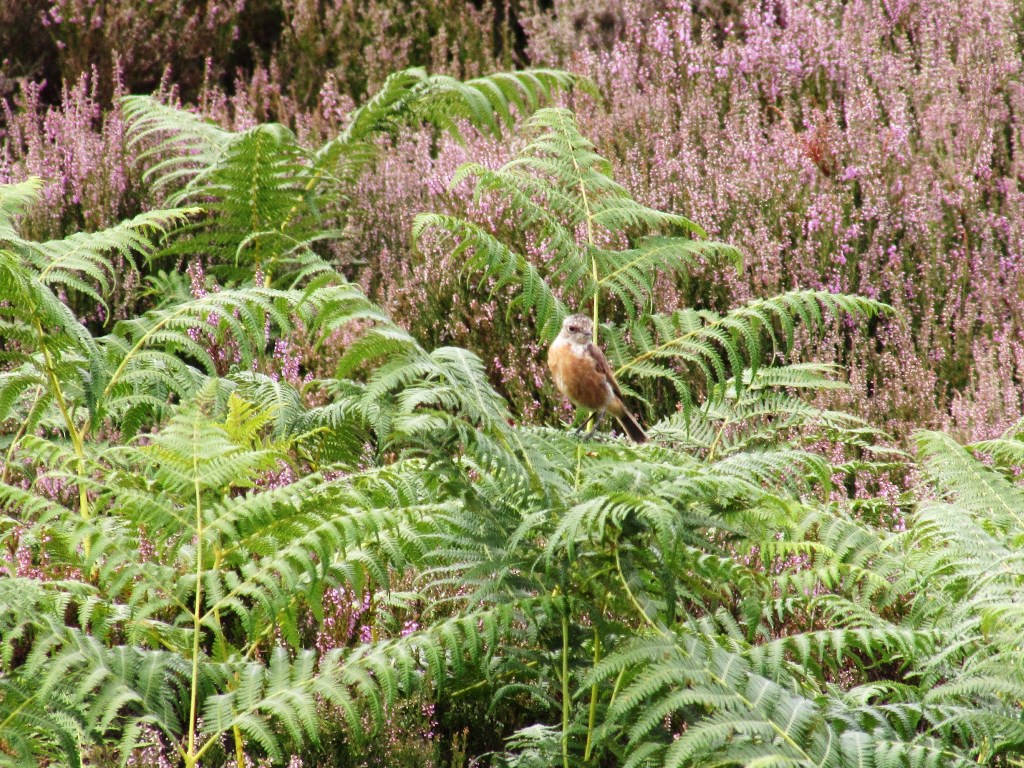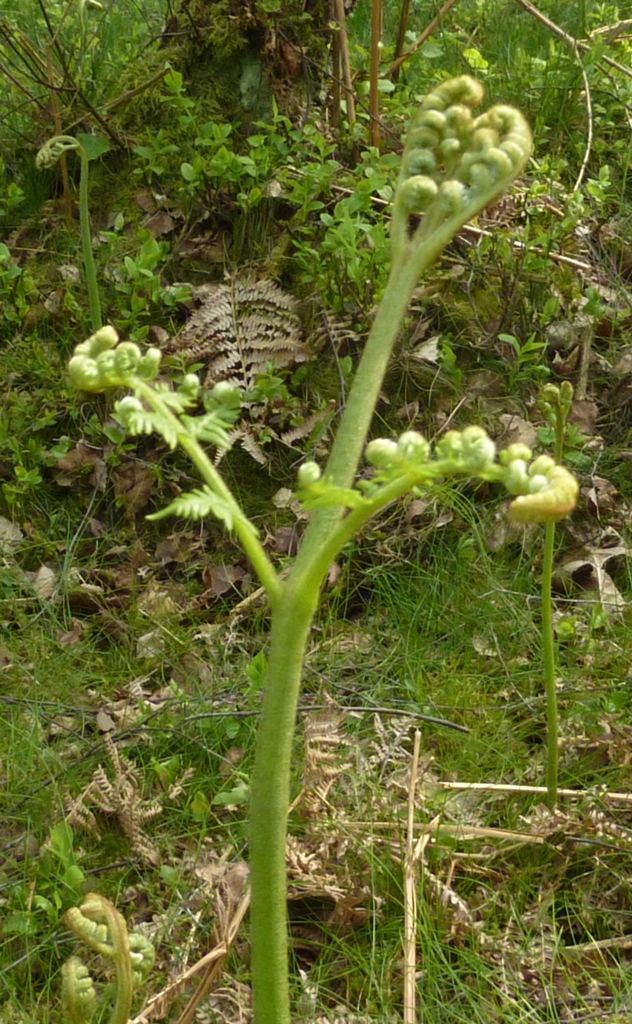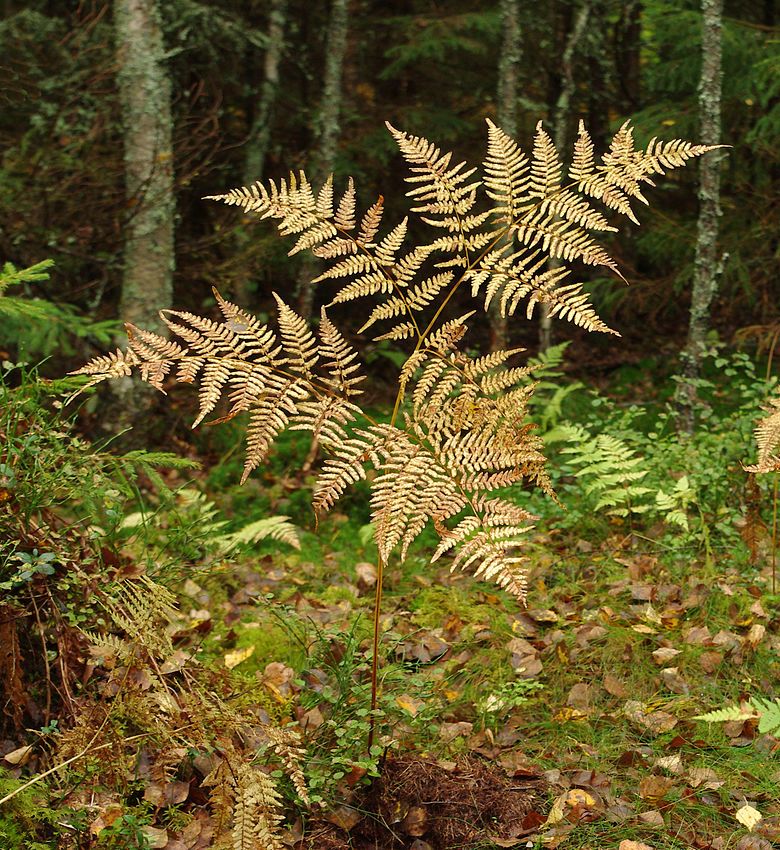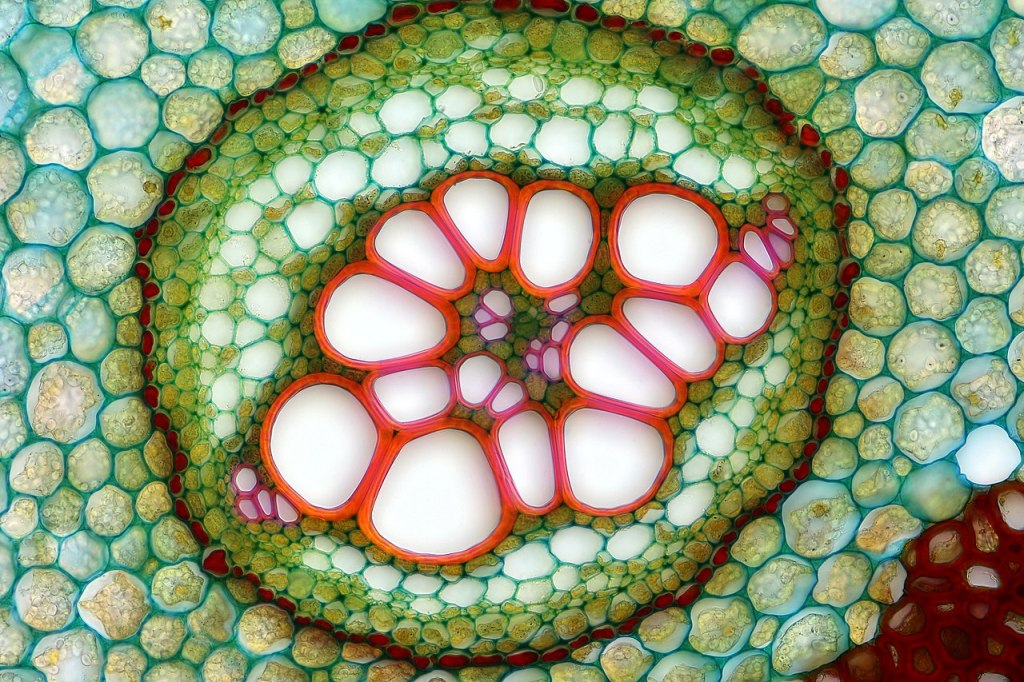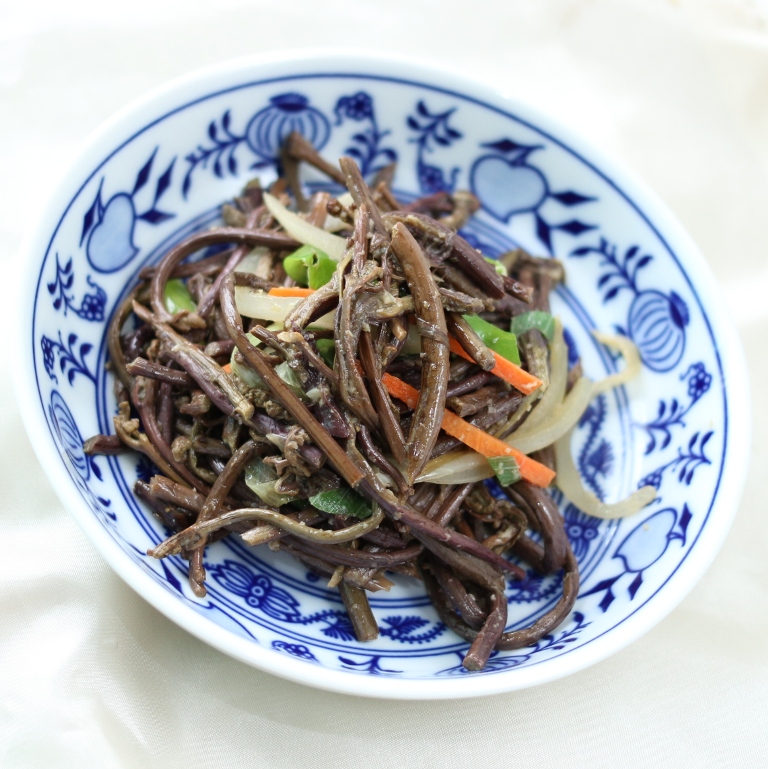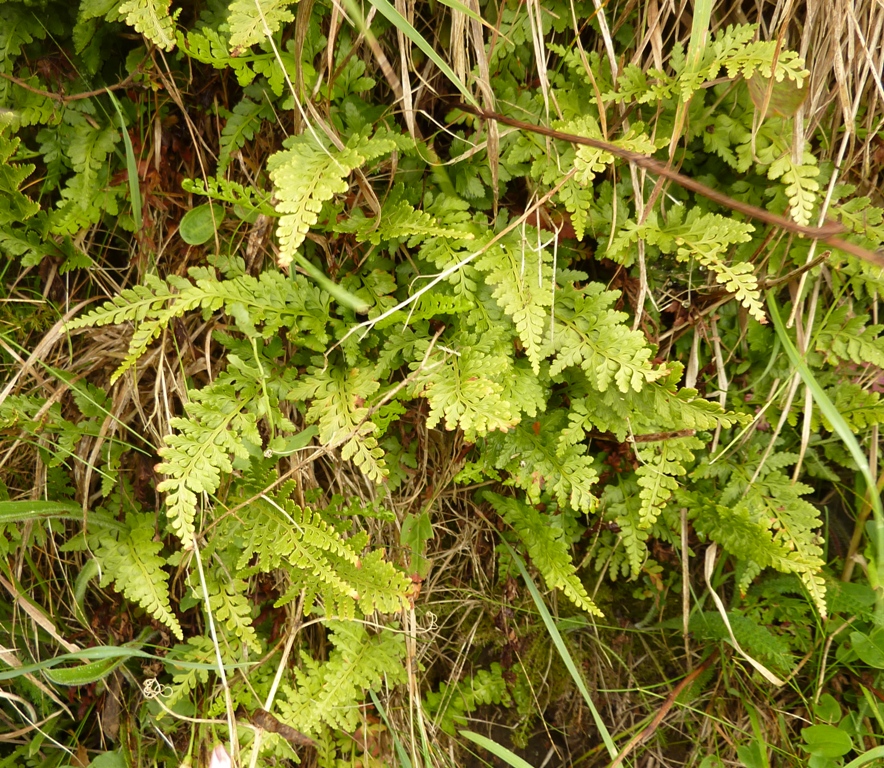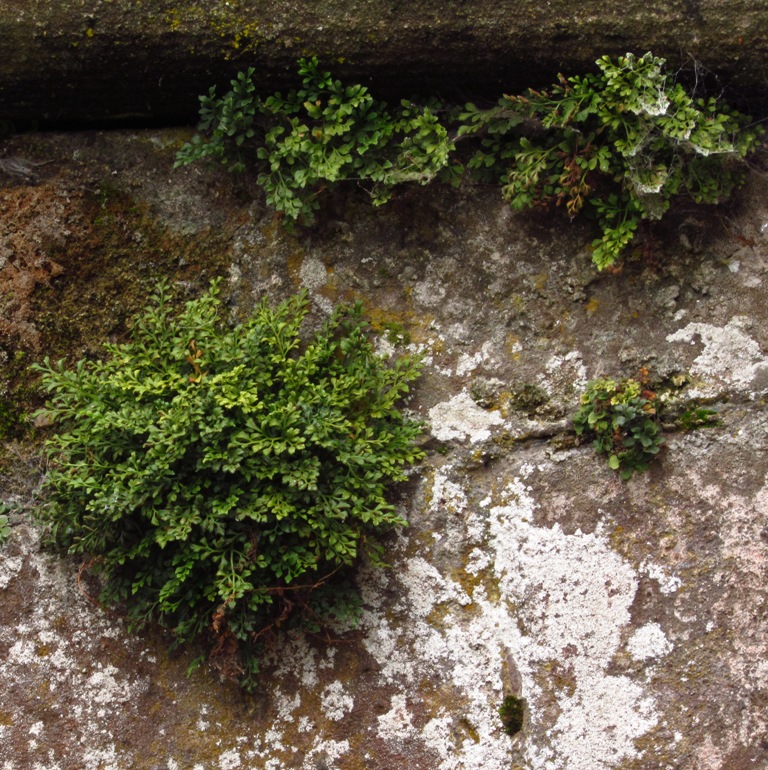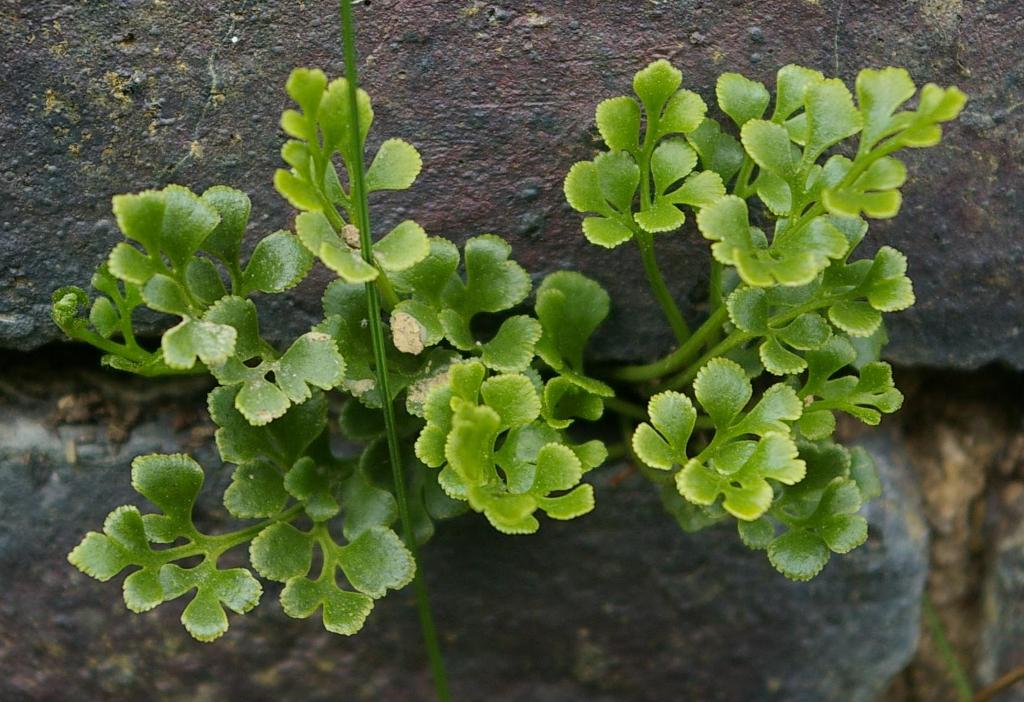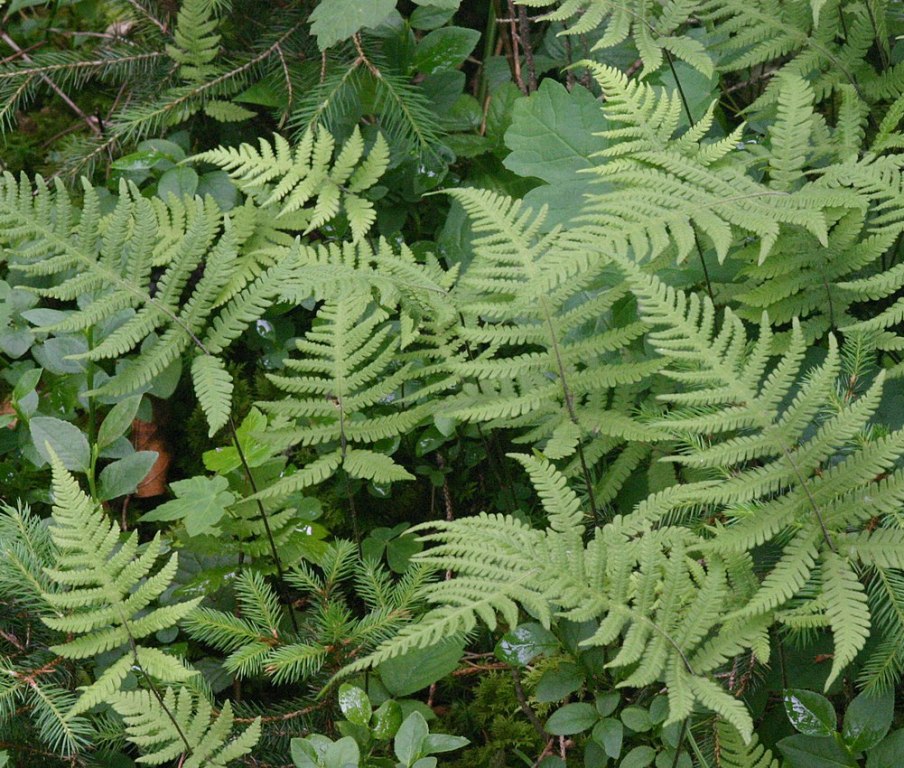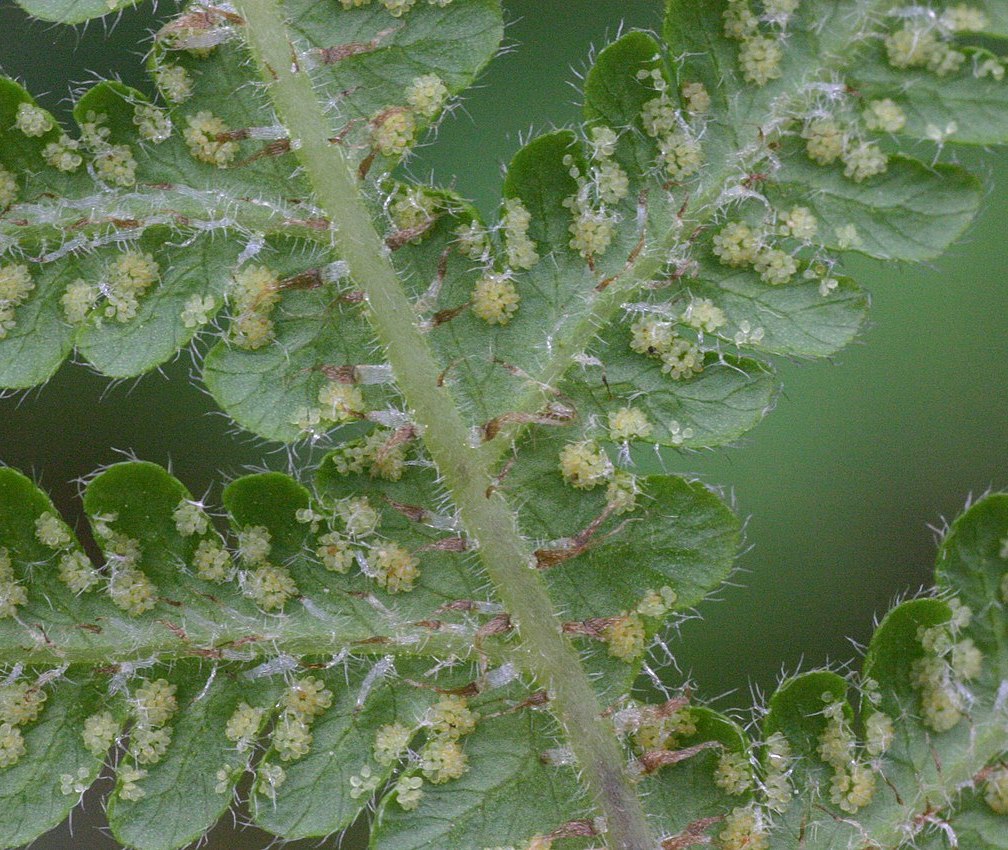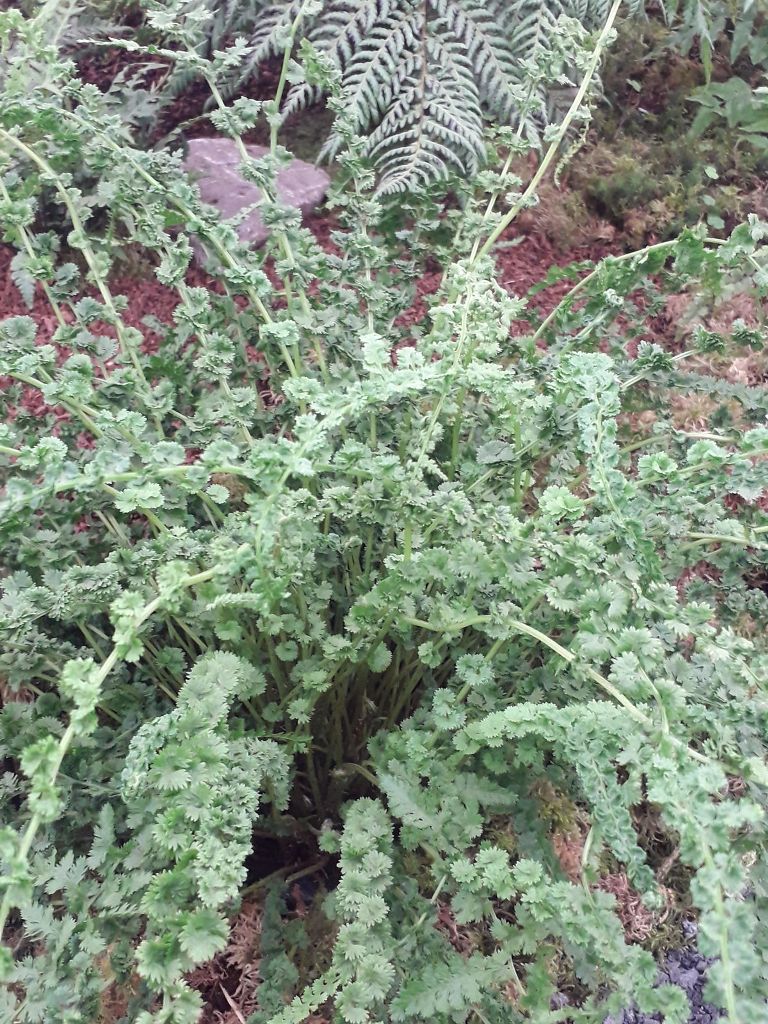in Part 2 we continue with the:
‘TRUE’ or LEPTOSPORANGIATE FERNS
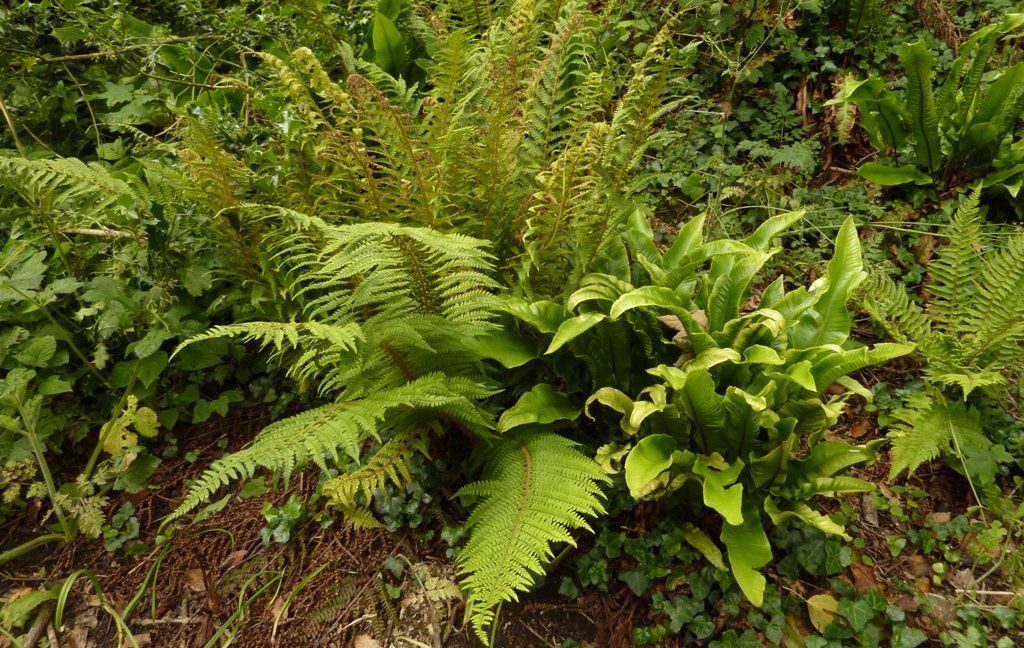
This has 16 families described in Stace, and on the next page, we continue with family 10 to the last family 21, which all grow in the British Isles in various habitats.
I use colour coding for easy reading! Blue background is general interesting info (although I hope you find it all interesting!!). Green is about all the uses except for medicinal uses or if there is a warning in which case I use a pink background. Pictures by Matt Summers unless stated.
I added contents where you can jump to the correct fern family or genus on next page.
Classification of fern families in Stace:
Contents:
10 DICKSONIACEAE –Tree fern Family
11 DENNSTAEDTIACEAE – Bracken family
Pteridium aquilinum or Bracken
12 PTERIDACEAE – Ribbon Fern family
- Cryptogramma crispa or Parsley Fern
- Anogramma leptophylla or Jersey Fern
- Adianthum capillus-venerisor Maidenhair Fern
- Pteris vittata and P. cretica or Ribbon Fern
13 CYSTOPTERIDACEAE
Gymnocarpium
- Gymnocarpium dryopteris or Oak Fern
- G. robertianum or Limestone Fern
Cystopteris
- Cystopteris fragilis or Brittle Bladder-fern
- C. diaphana or Diaphanous Bladder-fern
- C. alpina or Alpine Bladder-fern
- C. dickieana or Dickie’s Bladder-fern
- C. montana or Mountain Bladder-fern
14 ASPLENIACEAE –Spleenwort family
- Asplenium scolopendrium (Syn. Phyllitis scolopendrium) or Hart’s-tongue Fern
- A. adiantum-nigrum or Black Spleenwort
- A. marinum or Sea Spleenwort
- A. trichomanes or Maidenhair Spleenwort
- A. ruta-muraria or Wall-rue
- A. ceterach (syn. Ceterach officinarum) or Rustyback
15 THELYPTERIDACEAE – Marsh Fern family
- Thelypteris palustris or Marsh Fern
- Phegopteris connectilis or Beech Fern
- Oreopteris limbosperma or Lemon-scented Fern
16 WOODSIACEAE or Woodsia family
- Woodsia ilvensis or Oblong Woodsia
- Woodsia alpina or Alpine Woodsia
17 ATHYRIACEAE – Lady-ferns and allies
- Athyrium filix-femina or Lady-fern
- Athyrium distentifolium or Alpine Lady-fern
18 BLECHNACEAE – Hard-fern family
- Blechnum spicant or Hard-fern
- Blechnum penna-marina or Little Hard-fern
- Blechnum cordatum or Greater Hard-fern
19 ONOCLEACEAE – Ostrich fern family
19A DAVALLIACEAE (for ornamental Davallia canariensis)
20 DRYOPTERIDACEAE – Buckler-fern family
- Cyrtomium falcatum or House Holly-fern
Polystichum
- Polystichum setiferum or Soft Shield-fern
- P. aculeatum or Hard Shield-fern
- P. lonchitis or Holly-fern
Dryopteris or Buckler-ferns
- Dryopteris oreades or Mountain Male-fern
- D. filix-mas or Male-fern
- D. affinis or Golden-scaled Male-fern
- D. affinis ssp. cambrensis
- D. affinis ssp. borreri
- D. affinis ‘Cristata’
- D. remota or Scaly Buckler-fern
- D. aemula or Hay-scented Buckler-fern
- D. submontana or Rigid Buckler-fern
- D. carthusiana or Narrow Buckler-fern
- D. dilatata or Broad Buckler-fern
- D. expansa or Northern Buckler-fern
21 POLYPODIACEAE – Polypody family
- Polypodium vulgare or Polypody
- P. interjectum or Intermediate Polypody
- P. cambricum or Southern Polypody
10 DICKSONIACEAE –Tree fern Family
This family is the interesting Tree fern family which has the prehistoric looking Australian Tree fern mostly seen in large (botanical) gardens: Dicksonia antarctica
11 DENNSTAEDTIACEAE – Bracken family
The main true fern in this family is a very well known plant in many parts of the world:
Pteridium aquilinum or Bracken
This is an important species of fern occurring in temperate and subtropical regions in both hemispheres. The extreme lightness of its spores has led to its global distribution.
Common bracken was first described as Pteris aquilina by Carl Linnaeus, in Volume 2 of his Species Plantarum in 1753. The origin of the specific epithet derived from the Latin aquila “eagle”. In the reprint of the Flora Suecica in 1755, Linnaeus explains that the name refers to the image of an eagle seen in the transverse section of the root.
Bracken readily colonises disturbed areas. It can be aggressive and invade native heather (Calluna vulgaris). Control programmes have been going on in various reserves, including at our nearby Cannock Chase.
“Controlling the bracken protects the heathland, which is very important for some of the rarest wildlife in the country, including the nightjar and woodlark, reptiles and a variety of insects, including rare butterflies.” Read more in this news article.
However noting all the valuable uses below: why can’t councils use alternative methods of controlling bracken instead of chemical spraying! Also take note private contractors: maybe an alternative source for making ‘alternative potting compost’?
The roots contain up to 20% potash in early summer, but this reduces to about 5% in the autumn.
The whole plant is a very valuable addition to the compost heap, it is rich in potash and makes an excellent compost for tree seeds. Cut twice a year if you want the plants to continue growing, three cuts annually will weaken and eventually kill off the plants.
Edible Uses:
Not so much in the British Isles except for perhaps North Wales and as a new foraging food?
- · Bracken is a widely eaten vegetable in Korea, Japan, Russian Far East, and parts of China. In Korea, bracken is known as gosari. It is soaked, parboiled, and stir-fried, and often eaten as a side dish (namul).It is also a classic ingredient of bibimbap.
- · In Japan, bracken is known as warabi and a jelly-like starch made from it is a key ingredient for the chilled dessert warabimochi.
- · As a type of sansai (mountain vegetables), young bracken shoots are steamed, boiled, or cooked in soups. The shoots are also preserved in salt, sake, or miso.
Many more edible uses by PFAF:
The root can be cooked + dried and ground into a powder. The root is very fibrous so traditionally it was baked after being dried, the outer skin was peeled off and the roots pounded into a powder with sticks so that the inner fibres could be removed. The dried root will store for years. The root contains 60% starch. This starch can be extracted from the roots and is used in making dumplings which are eaten with soya flour and sugar as a delicacy.
Toxicity (also read the blue lock below):
The plant contains the carcinogenic compound ptaquiloside. High stomach cancer rates are found in Japan and North Wales, where the young stems are used as a vegetable, but it is unknown whether bracken plays any part at all. Consumption of ptaquiloside-contaminated milk is thought to contribute to human gastric cancer in the Andean states of Venezuela. The spores have also been implicated as carcinogens.
This woodland ways blog also doesn’t recommend eating or using bracken for medicines.
However, ptaquiloside is water soluble, and is reduced by soaking bracken in cool water. Korean and Japanese cooks have traditionally soaked the shoots in water and ash to detoxify the plant before eating. Ptaquiloside also degenerates at room temperature, which explains why the rat studies were done with the toxin stored at −20 °C (−4 °F). At boiling temperature, the carcinogen denatures almost completely.Salt and baking soda also help with volatilizing the chemical.
Other Uses:
- Bracken shoots have been used to produce beer in Siberia, and among indigenous peoples of North America.
- The rhizome can be ground into flour to make bread. In the Canary Islands, the rhizome was historically used to make a porridge called gofio.
- Bracken leaves are used in the Mediterranean region to filter sheep’s milk, and to store freshly made ricotta cheese.
- A glue can be made from the rootstock
- A brown or green dye is obtained from the fronds.
- The fibrous remnants from edible roots make a good tinder.
- The rhizome lathers readily in water and can be used as a soap.
- A decoction of the root has been used as a hair wash. The roots have been rubbed into the scalp in order to promote hair growth.
- The roots have been pounded to remove the bark, then split into flat bands and used as the black strands of cheap baskets.
- The ashes of the plant are rich in potassium and could be used as a fertilizer.
- They are also used in the manufacture of glass (when mixed with sand) and in making soap (when mixed with vegetable oil).
- The dried ferns produce a very durable thatch.
- The leaves are used as a packing material for fruit, keeping it fresh and cool without imparting any colour or flavour.
- They are also used as a lining for baskets, fruit drying racks etc and as a bedding. The leaves repel insects and can help to prevent rot in the fruits etc.
- Dried bracken fronds are very useful in the garden as a mulch for somewhat tender plants. This will keep the soil warmer, protect from wind damage and also keep off some of the rain.
- Personally I use the bracken in Christmas wreaths as it gives a beautiful golden addition!
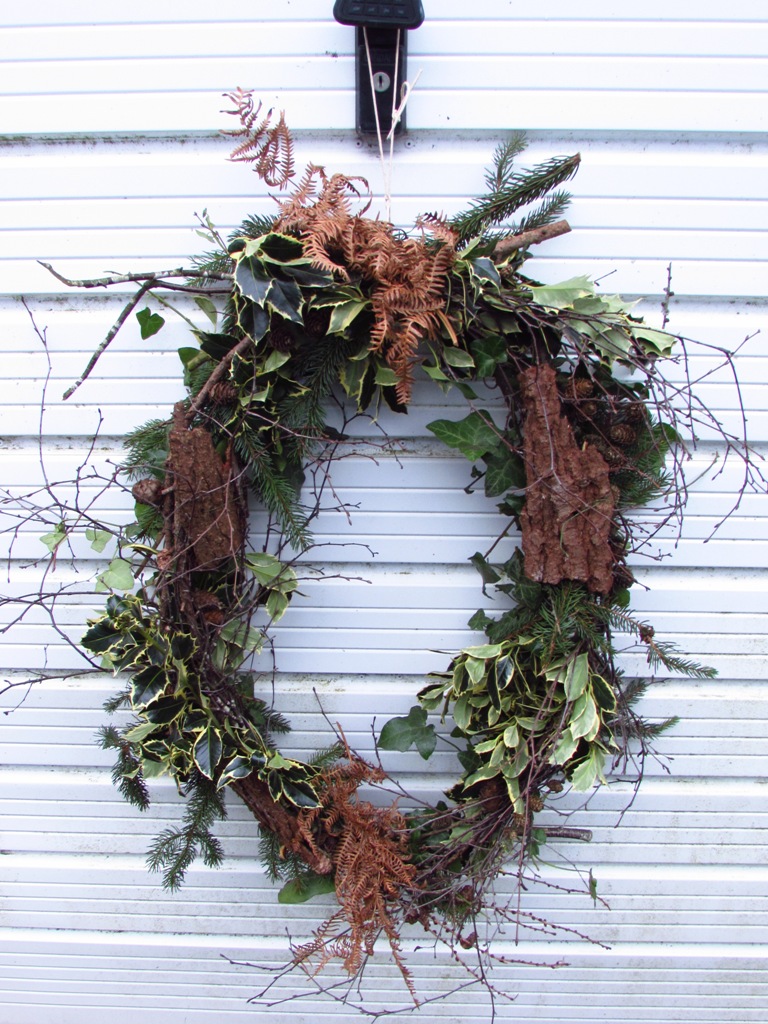
This is controversial because of the carcinogenic qualities and therefore only qualified herbalist should advice you here!
- The young shoots are diuretic, refrigerant and vermifuge.
- They have been eaten as a treatment for cancer.
- The leaves have been used in a steam bath as a treatment for arthritis.
- A decoction of the plant has been used in the treatment of tuberculosis.
- A poultice of the pounded fronds and leaves has been used to treat sores of any type and also to bind broken bones in place.
- The root is antiemetic, antiseptic, appetizer and tonic.
- A tincture of the root in wine is used in the treatment of rheumatism.
- A tea made from the roots is used in the treatment of stomach cramps, chest pains, internal bleeding, diarrhoea, colds and also to expel worms.
- The poulticed root is applied to sores, burns and caked breasts!
12 PTERIDACEAE – Ribbon Fern family

Cryptogramma crispa or Parsley Fern
Cryptogramma crispa grows among acidic rocks in areas where snow lies until late in the year. It is a pioneer species on stable scree slopes and also occurs on cliffs and dry stone walls.
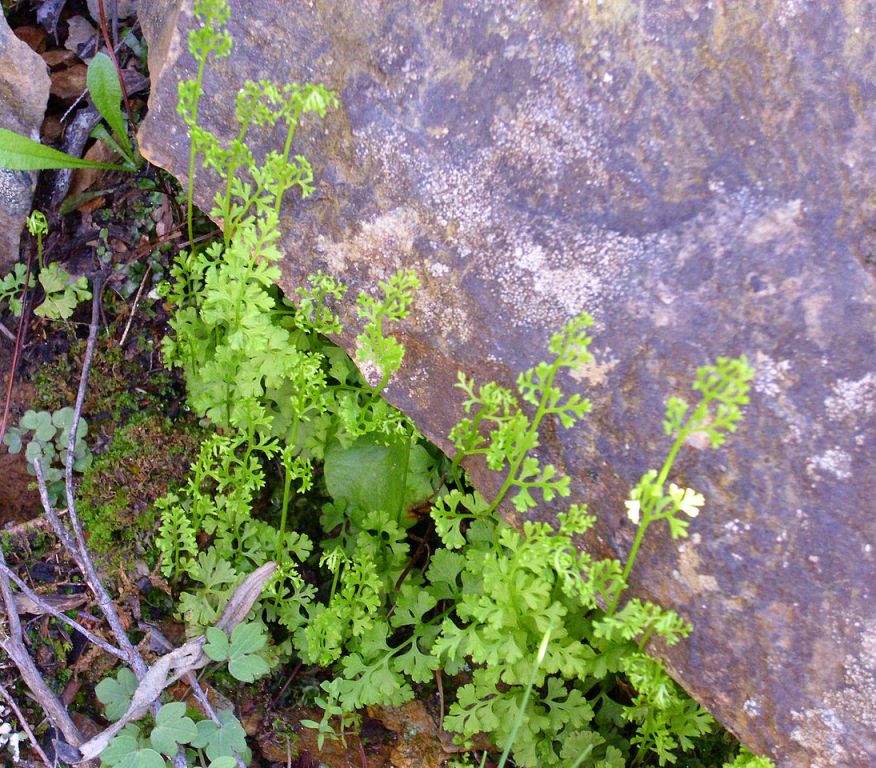
Anogramma leptophylla or Jersey Fern
A small rare fern in the B.I. but found frequent on Jersey and on 1 site in Guernsey on moist but well-drained shady lane banks, especially where granite is used to support the bank. It prefers bare soil where some surface erosion reduces competition.
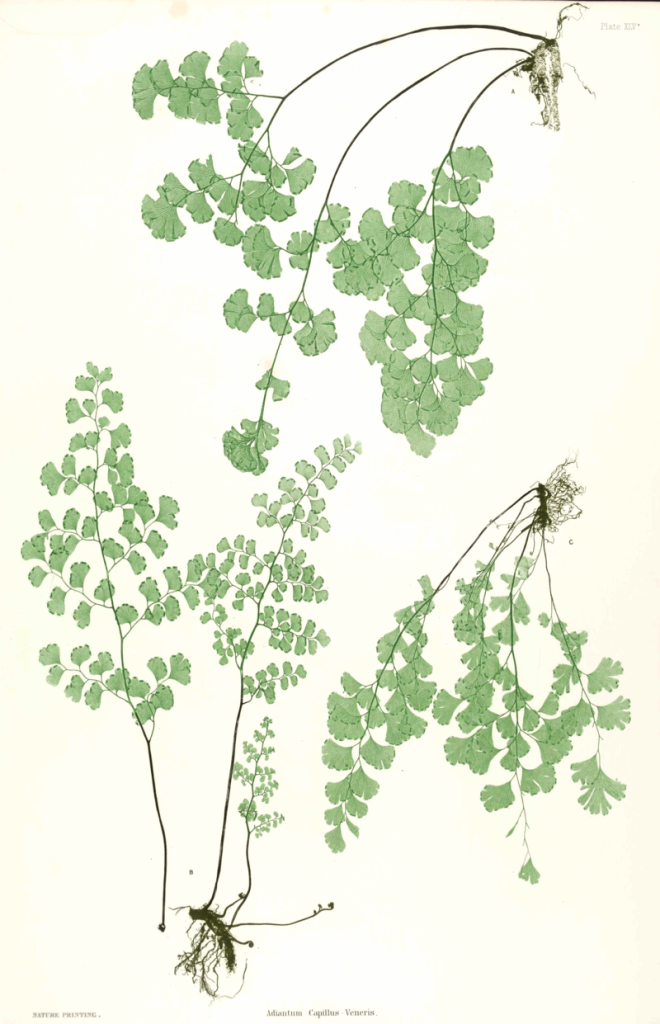
Adianthum capillus-venerisor Maidenhair Fern
A delicate, semi-evergreen fern found in areas with an oceanic climate on wet, calcareous cliffs where its rhizomes are protected in crevices, etc.
This lovely fern is cultivated and widely available around the world for planting in natural landscape native plants and traditional shade gardens, for outdoor container gardens, and commonly as an indoor houseplant.
In the Medicinal Flora by Barker it is used for cough with pharangitis or bronchitis and nasal catarrh.
- the Navajo people of Kayenta, AZ use an infusion of the plant as a lotion for bumblebee and centipede stings.
- The Navajo people also smoke it or take it internally to treat mental illness.
- In the traditional medicine of Iran, frond infusion of Adiantum capillus-veneris is used for jaundice therapy.
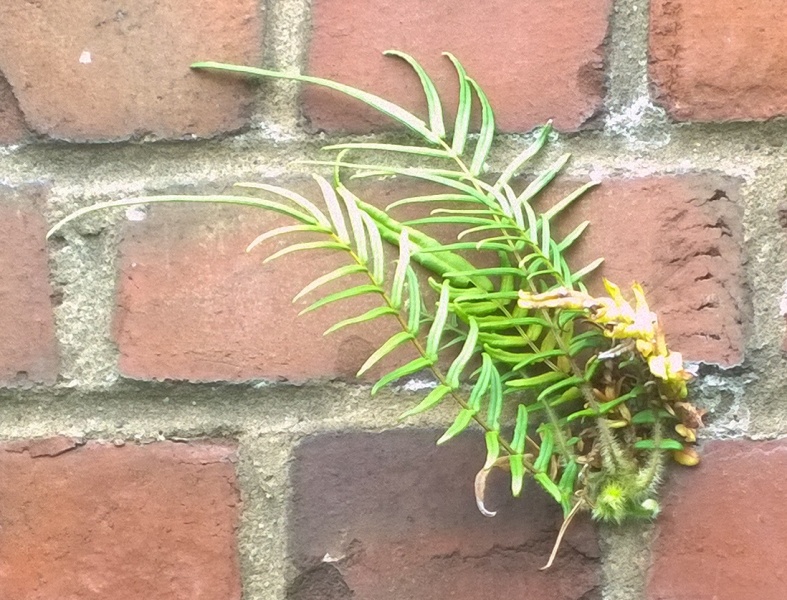
Pteris vittata and P. cretica or Ribbon Fern
These are not native but usually found as an escape on walls, etc.
Uses:
Although it grows readily in the wild, Pteris vittata is sometimes cultivated. It can be grown in gardens or containers for its attractive appearance.
Used in pollution control schemes: it is known to be a hyperaccumulator plant of arsenic used in phytoremediation.
13 CYSTOPTERIDACEAE (takes on Gymnocarpium, Cystopteris from Woodsiaceae since the last edition of Stace)
Cystopteridaceae are small or medium-sized ferns in forests and crevices. They generally have thin laminae, and small, round, naked sori.
Gymnocarpium
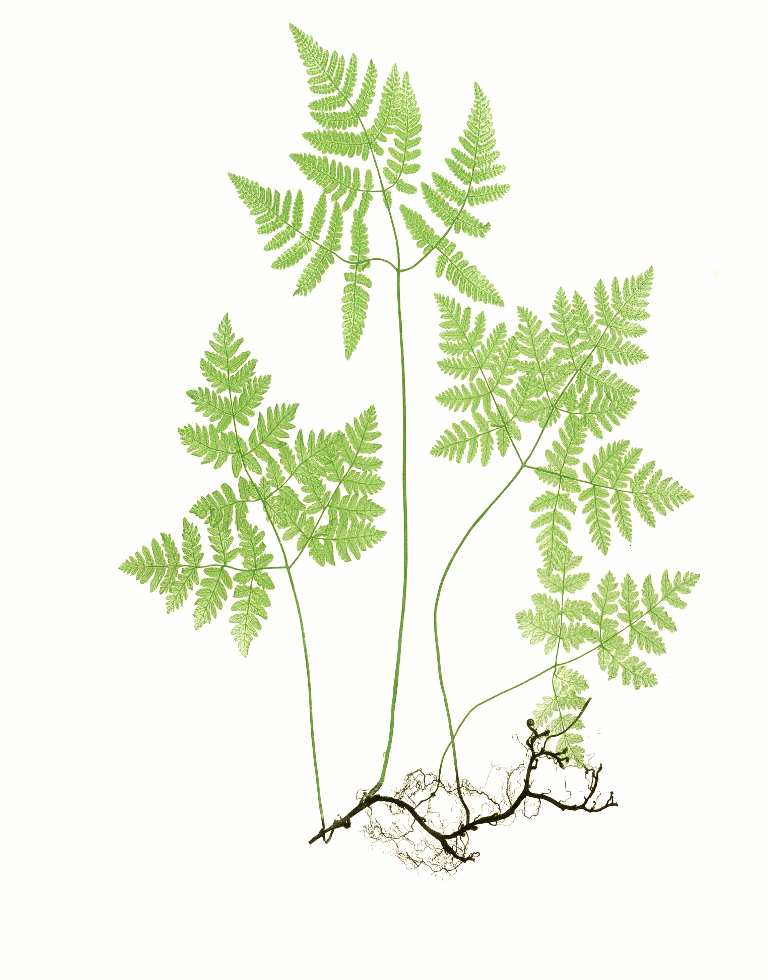
‘The ferns of Great Britain and Ireland’ in Wikipedia Commons.
Gymnocarpium dryopteris or Oak Fern
A gregarious, deciduous fern growing in rocky deciduous woodland and ravines, along stream banks, and on cliff ledges and stable block screes.
In cultivation in the UK this plant and the cultivar “Plumosum” have gained the Royal Horticultural Society’s Award of Garden Merit
G. robertianum or Limestone Fern
A deciduous fern of cracks, fissures and scree in limestone rock, but also found in shallow grikes of limestone pavement, and, rarely, on chalk.
Cystopteris or Bladder-ferns
This genus has 5 native species:
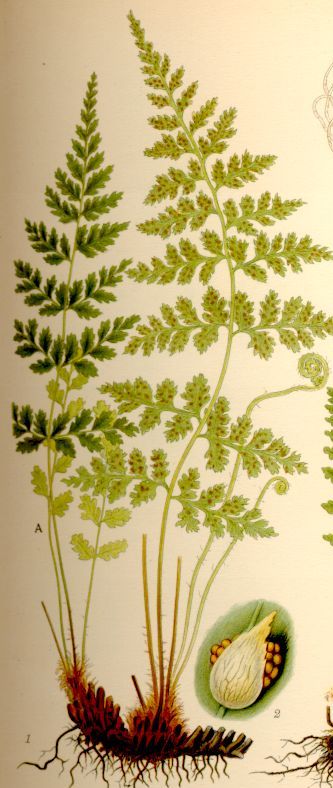
C. fragilis or Brittle Bladder-fern
A fern of damp, shaded rock crevices, cliffs, cave entrances, ravines and mortared walls, always growing on a mineral-enriched substrate, and most frequent over limestone.
C. diaphana or Diaphanous Bladder-fern
C. alpina or Alpine Bladder-fern
C. dickieana or Dickie’s Bladder-fern
C.montana or Mountain Bladder-fern
14 ASPLENIACEAE –Spleenwort family
Aspleniaceae has 10 native species in the B.I. and many hybrids according to Stace.
Just a few of the more common ones:

Asplenium scolopendrium (Syn. Phyllitis scolopendrium) or Hart’s-tongue Fern
The most striking and unusual feature of the fern is its simple, undivided fronds. The leaves’ supposed resemblance to the tongue of a hart (an archaic term for a male red deer) gave rise to the common name “hart’s-tongue fern”.
Uses:
Asplenium scolopendrium is often grown as an ornamental plant, with several cultivars selected with varying frond form, including with frilled frond margins, forked fronds and cristate forms. The species has gained the Royal Horticultural Society‘s Award of Garden Merit,] as has the cultivar ‘Angustatum’.

Asplenium adiantum-nigrum or Black Spleenwort
This evergreen perennial fern occurs on a wide range of well-drained, usually basic substrates, in lightly shaded habitats where there is little competition.
A. marinum or Sea Spleenwort
An evergreen perennial fern, predominantly found in cool, moist crevices and fissures in maritime cliffs, and often within range of sea-spray.
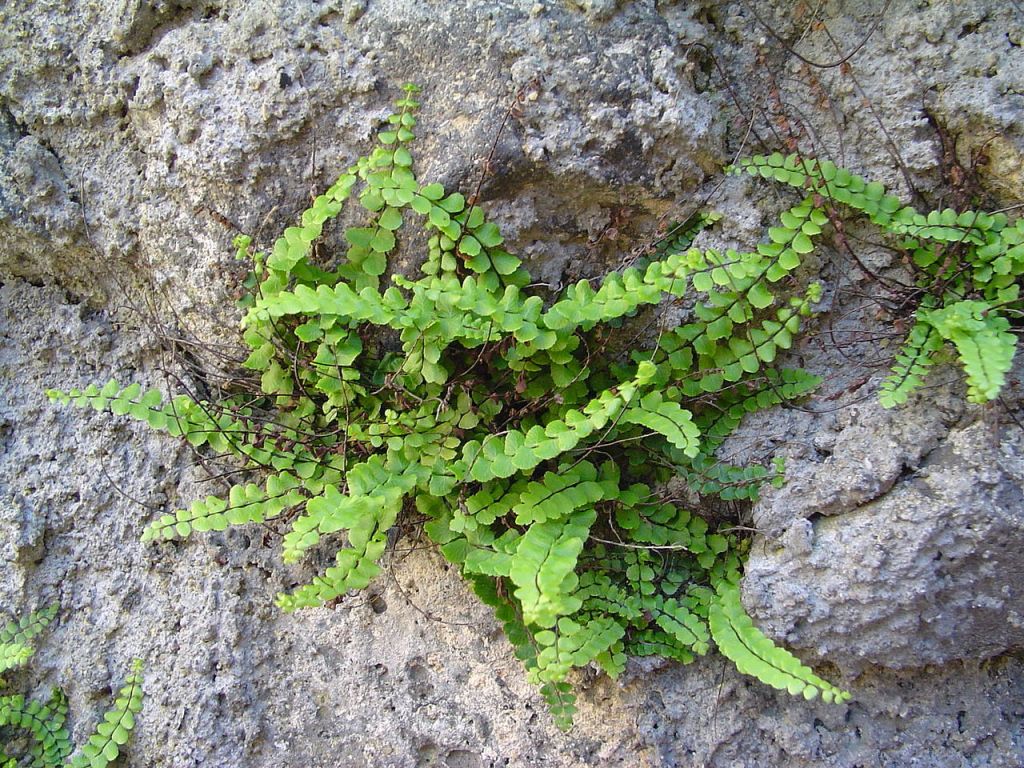
A. trichomanes or Maidenhair Spleenwort
Asplenium trichomanes is valued in cultivation for its hardiness (down to −20 °C (−4 °F)), its evergreen foliage and its ability to colonise crevices in stone walls. It prefers a fully or partially shaded aspect. It has gained the Royal Horticultural Society’s Award of Garden Merit.
A. ruta-muraria or Wall-rue
This perennial, evergreen fern occurs naturally on limestone and other basic rocks, where it grows on steep, bare faces and in crevices. However, in most lowland areas it is now abundant on mortared walls and other man-made structures.
- The fronds are astringent, deobstruent, emmenagogue, expectorant and ophthalmic.
- A distilled water made from the fronds has proved of benefit in the treatment of many eye complaints.
- The plant is also considered to be useful in the treatment of coughs and ruptures in children.
- It was at one time used as a herbal remedy for rickets and its tannin content renders it suitable for stopping bleeding from small wounds.

A. ceterach (syn. Ceterach officinarum) or Rustyback
A perennial, calcicole fern found on crags and cliffs of basic rocks, especially limestone, and also on limestone pavements and mortared walls.
The trichomes (hairs) on the lower surface of the fronds are orange-brown in colour, hence the name “rustyback”.
This fern is well known as a resurrection plant due to its ability to withstand desiccation and subsequently recover on rewetting.
15 THELYPTERIDACEAE – Marsh Fern family
This family has 3 native genera & species:
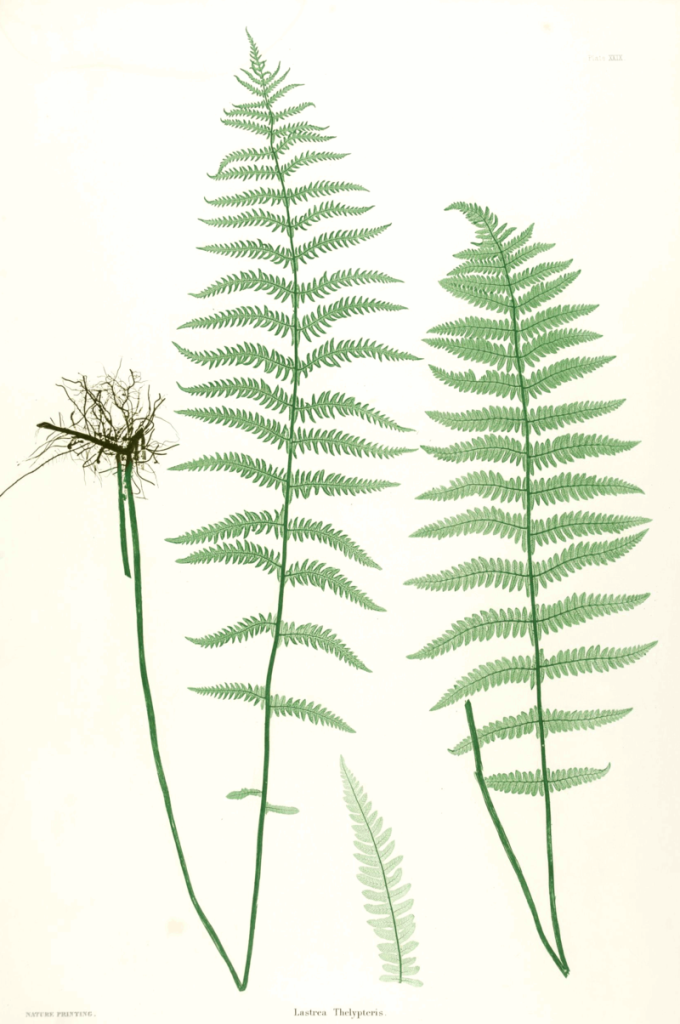
Thelypteris palustris or Marsh Fern
A perennial fern of open or recently wooded fen or open carr, where the soil is permanently wet and organic, but not too acidic.
Phegopteris connectilis or Beech Fern
A creeping, rhizomatous fern, most common in ancient woodlands dominated by Quercus petraea on neutral to acidic soils.
Oreopteris limbosperma or Lemon-scented Fern
A fern of acidic, peaty or humus-rich soils in open woodland, along drainage ditches and stream-sides, and on damp heaths, upland grassland and damp rock ledges. It is especially associated with the edges of watercourses, including man-made ditches, and is therefore more frequent on poorly-drained substrates.
16 WOODSIACEAE or Woodsia family
This family has now only got 1 genus:
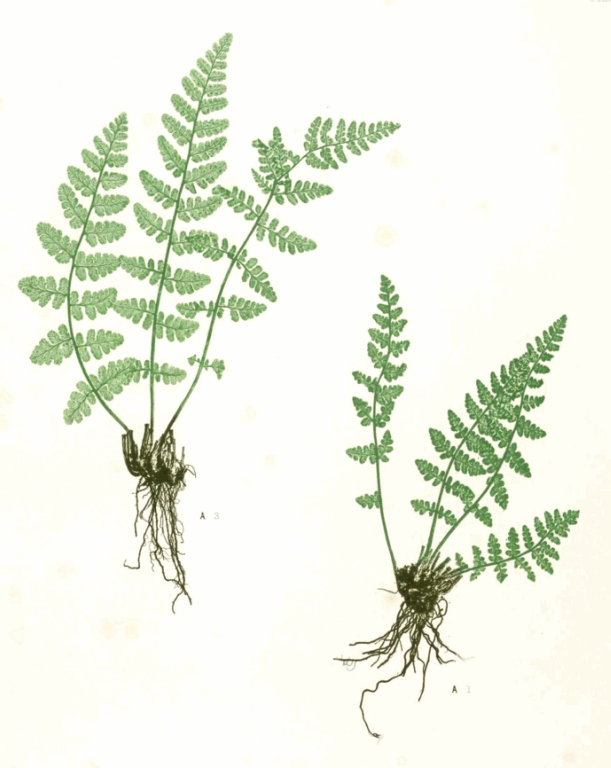
Woodsia ilvensis or Oblong Woodsia
An evergreen fern, growing in cracks and fissures in cliffs and crags on rocks ranging from calcareous tuffs and hornblende schists to more acidic tuffs, grits and shales.
Victorian collectors and modern conservation:
Oblong woodsia came under severe threat from Victorian fern collectors in the mid 19th century in Scotland, especially in the Moffat Hills. These hills once had the most extensive UK populations of the species but there now remain only a few small colonies whose future is under threat. This period of collecting became known as pteridomania (or “fern-fever”). The Royal Botanic Garden Edinburgh plan to use cultivated specimens and a spore bank to restore depleted wild populations.
Woodsia alpina or Alpine Woodsia
17 ATHYRIACEAE – Lady-ferns and allies
Athyrium filix-femina or Lady-fern
A deciduous fern that prefers moist but well-drained acidic soils, but can tolerate more basic substrates if these are overlain by mildly acidic layers.
It is one of few species able to colonise metalliferous lead and tin mine deposits.
Numerous cultivars have been developed for garden use, of which the following have gained the Royal Horticultural Society‘s Award of Garden Merit:
- A. filix-femina
- A. filix-femina ‘Vernoniae’
- · A. filix-femina ‘Frizelliae’
The young fronds are edible after cooking; Native Americans cooked both the fiddleheads and the rhizomes.
A. distentifolium or Alpine Lady-fern
A deciduous fern of the higher mountains, growing on rock ledges, gullies, block screes and in shallow hollows where snow lies late into summer.
18 BLECHNACEAE – Hard-fern family
This family has one native and 2 introduced species escaped from gardens.
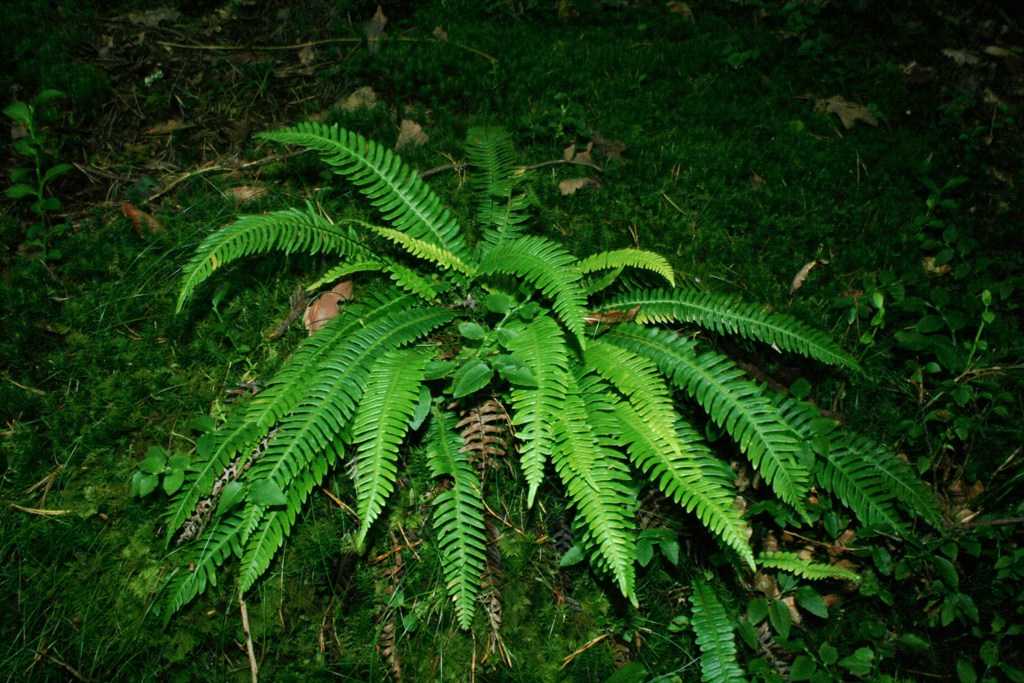
Blechnum spicant or Hard-fern
This evergreen calcifuge fern grows on damp peaty or loamy soils in deciduous and coniferous woodland.
An attractive fern which also has edible and medicinal uses but more when anything else is not available! See PFAF website.
The two non-natives are:
Blechnum penna-marina or Little Hard-fern
This is an evergreen, known as Antarctic hard-fern, alpine water fern and pinque (Chilean Spanish), with a natural range from the Araucanía Region to the south and from the coast to the tree line of the Magellanic forests in Chile and adjacent areas of Argentina. It is also found in New Zealand, Australia and some Pacific islands.
In cultivation this hardy species has gained the Royal Horticultural Society‘s Award of Garden Merit.
Blechnum cordatum or Greater Hard-fern
A large,(neophyte) evergreen fern with a shortly creeping rhizome which eventually forms a small trunk. This plant has gained the Royal Horticultural Society‘s Award of Garden Merit. I have seen this fern for the first time at Trelisick Gardens in Cornwall when I had one of my first work experiences as a gardener!
19 ONOCLEACEAE – Ostrich fern family
This has the ornamental Matteuccia struthiopteris (Ostrich or Shuttlecock fern) in it, as well as Onoclea sensibilis (Sensitive fern). Please look at the links for more info.
19A DAVALLIACEAE (for ornamental Davallia canariensis)
20 DRYOPTERIDACEAE – Buckler-fern family
This large family on the British Isles has 2 main genera as well as one non-native:
Cyrtomium falcatum or House Holly-fern
The first date of cultivation of C. falcatum in Britain is unknown, but it was grown in Tresco, Isles of Scilly, by 1894 and it is very popular as a house and greenhouse plant. Also seen it grown in town gardens.
An attractive, evergreen garden and houseplant fern.
Polystichum or Shield-ferns
This genus has 3 native and 1 introduced & naturalized species as well as many hybrids according to Stace.
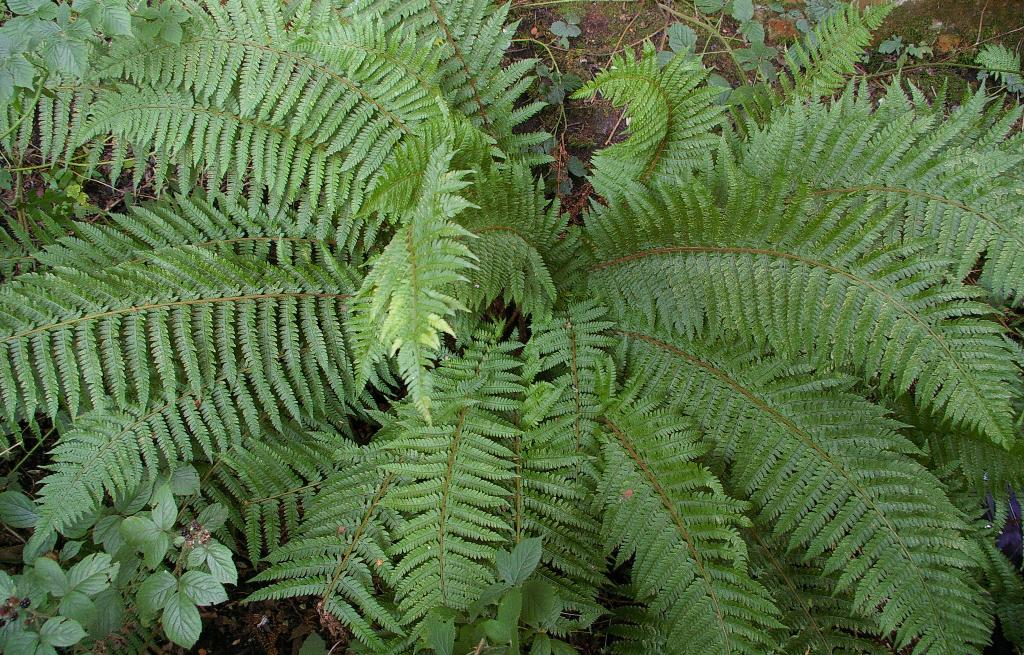
Polystichum setiferum or Soft Shield-fern
This semi-evergreen fern is a moderate calcicole, occurring in shaded deciduous woodland, hedgerows, lane banks and sheltered streamsides, and also in the peaty bottoms of grikes in limestone pavement.
Ornamental Uses:
Polystichum setiferum is frequently cultivated for use in gardens. There are many cultivars available: over 300 have been described although most are no longer in cultivation or not considered sufficiently distinct for an individual name. The following cultivars have gained the Royal Horticultural Society’s Award of Garden Merit:
- Divisilobum Group
- ’Divisilobum Densum’
- ‘Divisilobum Iveryanum’
- ‘Herrenhausen’
- Plumosomultilobum Group
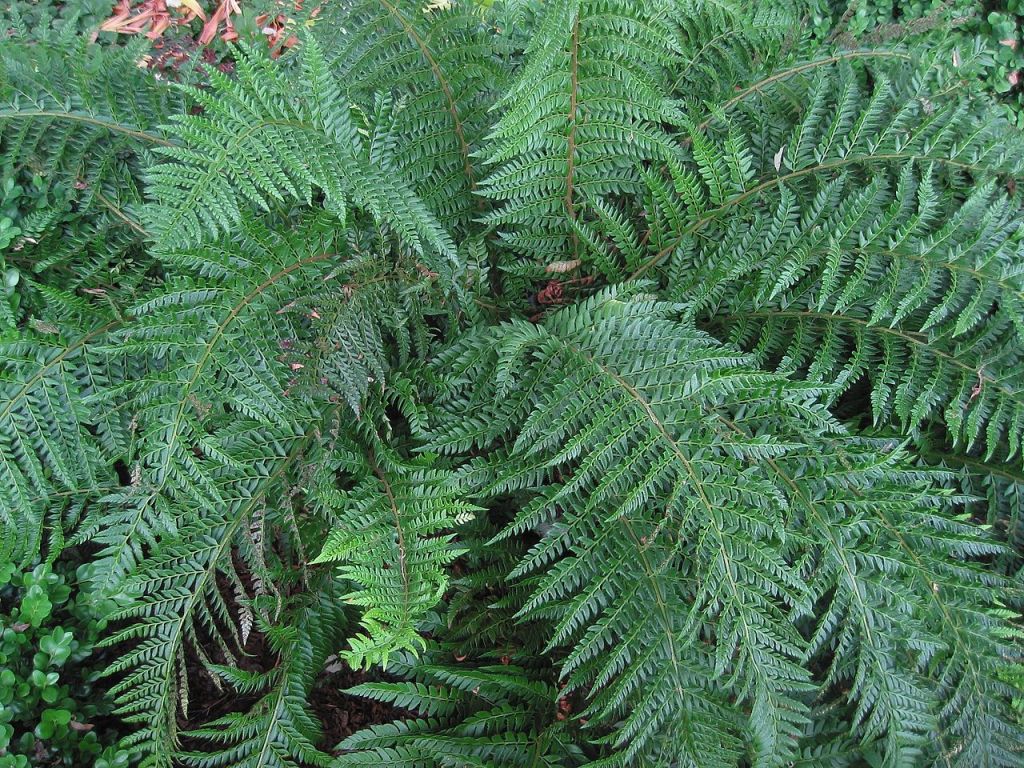
P. aculeatum or Hard Shield-fern
This evergreen species is characteristic of mountain gorges and steep wooded river valleys where it grows in thin but damp, mildly acidic to base-rich soils between rocks and in crevices.
It is an attractive fern which can be grown in gardens.
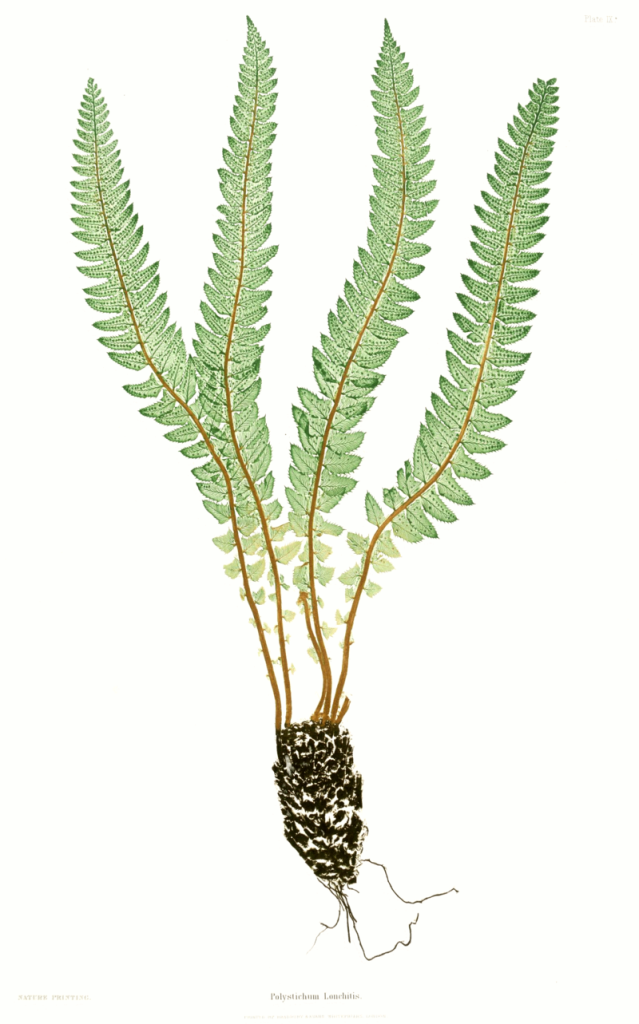
P. lonchitis or Holly-fern
This evergreen species is a calcicole, growing in well-drained, cool and moist positions at the base of cliffs, on rocky ledges, and particularly in stabilised boulder-scree.
Dryopteris or Buckler-ferns
This has now 12 species mentioned in Stace as well as many hybrids:
For the first three species follow this link for identifying purpose!
Dryopteris oreades or Mountain Male-fern
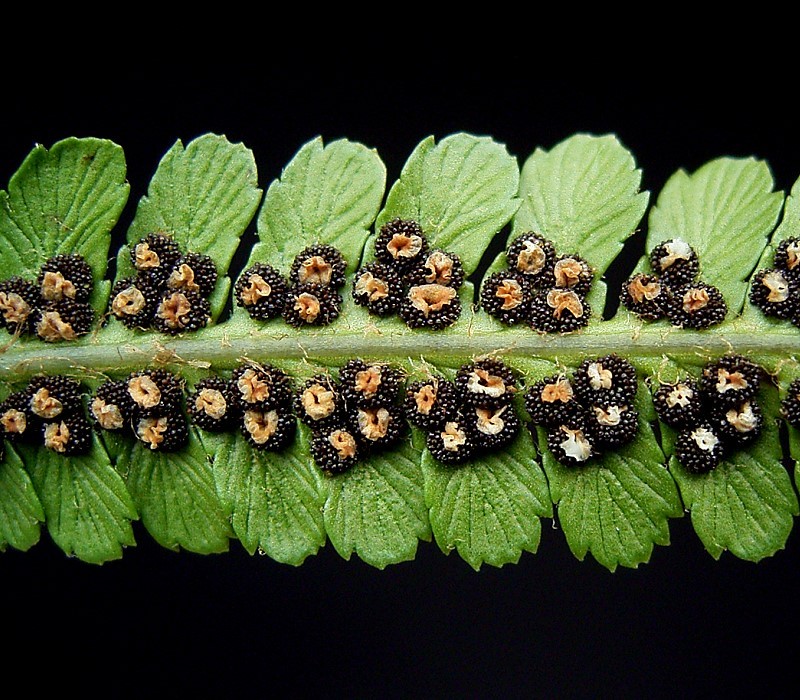
D. filix-mas or Male-fern
This is a common fern of the temperate Northern Hemisphere, native to much of Europe, Asia, and North America. It favours damp shaded areas in the understory of woodlands, but also shady places on hedge-banks, rocks, and screes.
Numerous cultivars have been selected for garden use. The following have gained the Royal Horticultural Society‘s Award of Garden Merit:
- D. filix-mas
- ‘Crispa Cristata’
- ‘Cristata’
- ‘Grandiceps Wills’
- ‘Linearis Polydactyla’
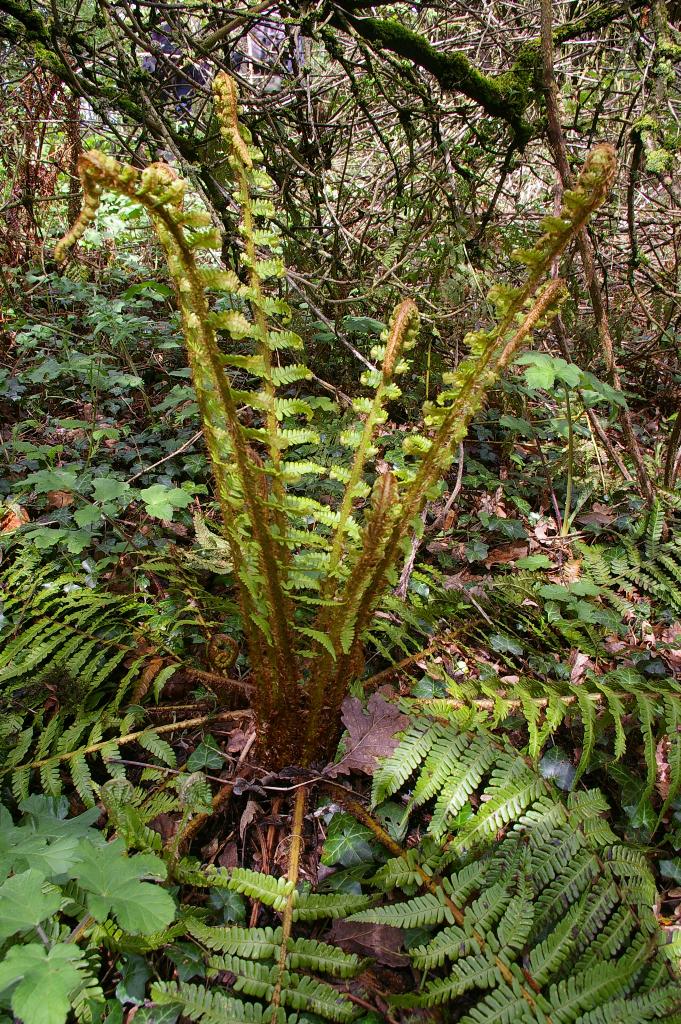
D. affinis or Golden-scaled Male-fern
A common, deciduous or evergreen fern found in deciduous woodland, along rides in coniferous plantations, in ditches, on shady banks and road verges, usually on acidic substrates.
D. affinis ssp. cambrensis (was formerly known as D. cambrensis or Narrow Male-fern )
D. affinis ssp. borreri (was formerly known as D. borreri or Borrer’s Male-fern)
D. affinis ‘Cristata’ (was formerly known as D. cristata or Crested Buckler-fern)
D. remota or Scaly Buckler-fern
D. aemula or Hay-scented Buckler-fern
D. submontana or Rigid Buckler-fern
A deciduous fern of limestone pavement, screes and rock crevices, where moist, humus-rich soils develop.
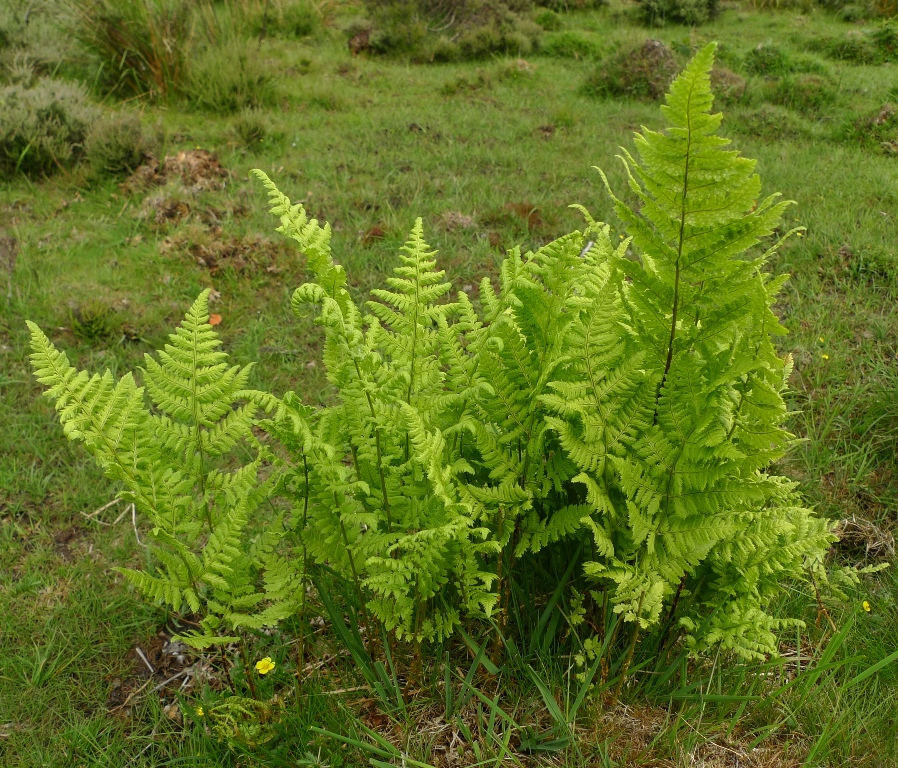
D. carthusiana or Narrow Buckler-fern
This deciduous fern is found in a range of damp habitats, including wet heaths, fens, mires, raised bogs, carr and wet woodland.
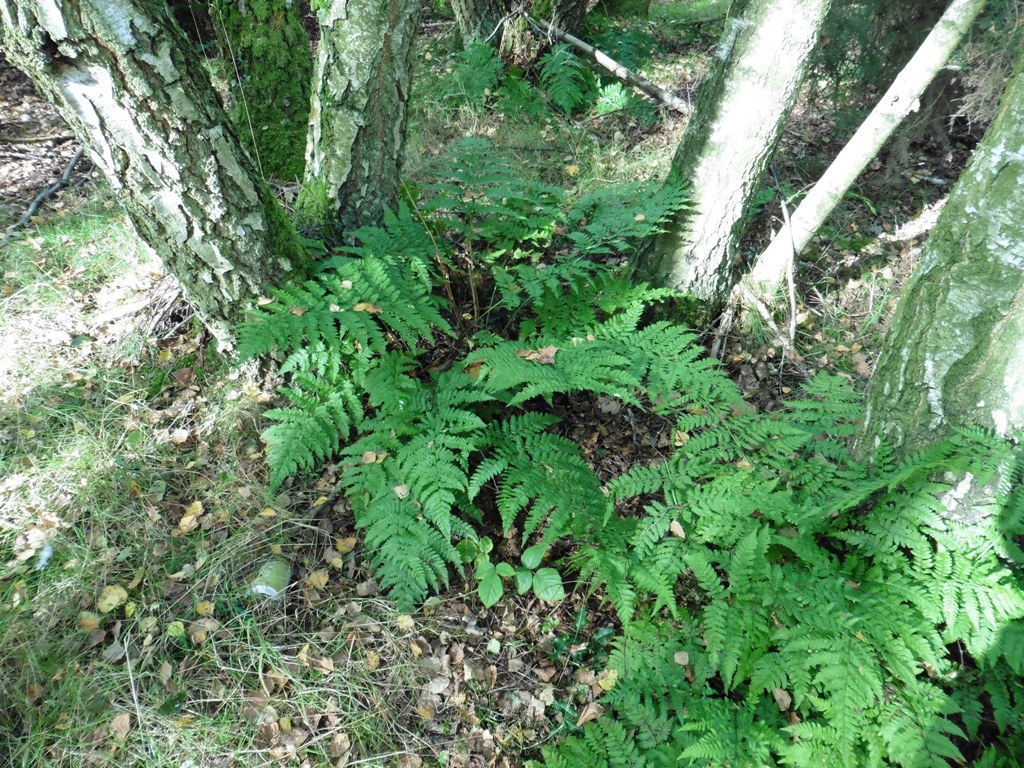
D. dilatata or Broad Buckler-fern
A common, deciduous fern grows on moderately to very acidic, well- to poorly-drained substrates.
D. expansa or Northern Buckler-fern
Polypodiaceae
21 POLYPODIACEAE – Polypody family
This is a large family in the world but only has 3 native species of Polypodium on the B.I.:
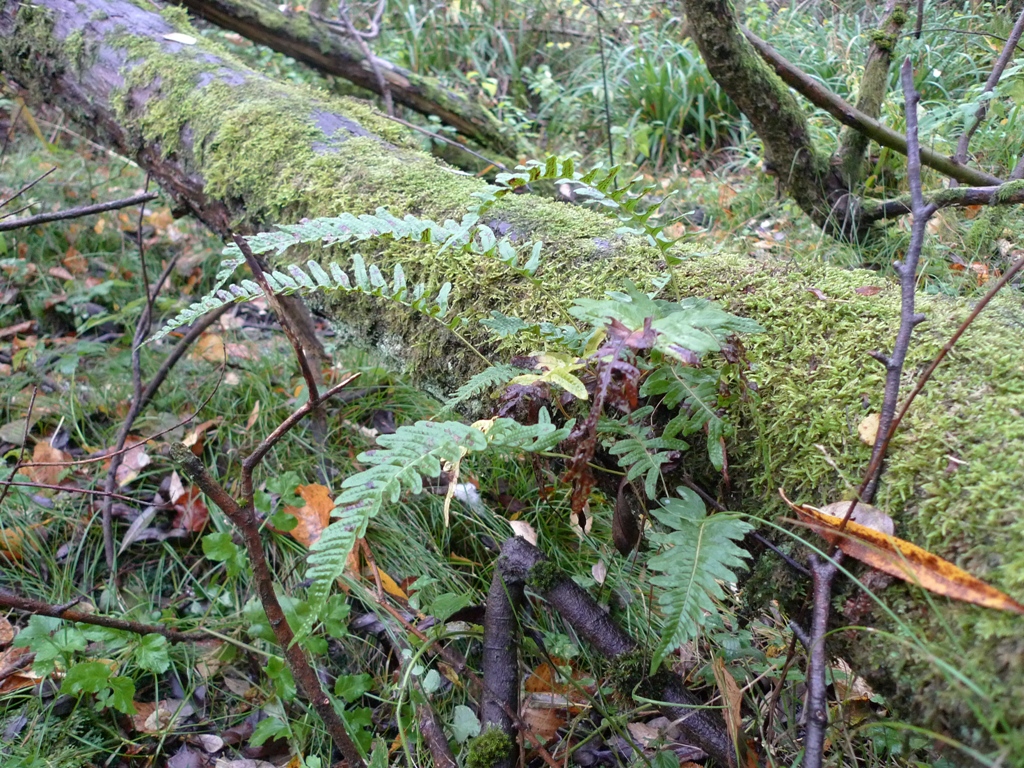
Polypodium vulgare or Polypody
An attractive, evergreen, perennial, rhizomatous fern of well-drained, predominantly acidic substrates, including dry-stone walls, roadside banks and rock outcrops. It also occurs as an epiphyte on Quercus and other deciduous trees.
The rhizome is very sweet; it contains sugars, tannin and oils. It is used as a liquorice adulterant. The root has a unique, rather unpleasant odour and a sweet (cloying) flavour at first though it quickly becomes nauseating. (Ken Fern) The rhizome contains 15.5% saccharose and 4.2% glucose.
It should not be used externally since it can cause skin rashes.
- Polypody stimulates bile secretion and is a gentle laxative.
- In European herbal medicine it is traditionally used as a treatment for hepatitis and jaundice and as a remedy for indigestion and loss of appetite.
- A tea made from the roots is used in the treatment of pleurisy, hives, sore throats and stomach aches and as a mild laxative for children.
- It was also considered of value for lung ailments and liver diseases.
- The poulticed root is applied to inflammations.
- A tea or syrup of the whole plant is anthelmintic.
P. interjectum or Intermediate Polypody
An evergreen, perennial, rhizomatous fern that prefers more basic substrates than P. vulgare but can be found in acidic conditions where exposed to salt-laden air.
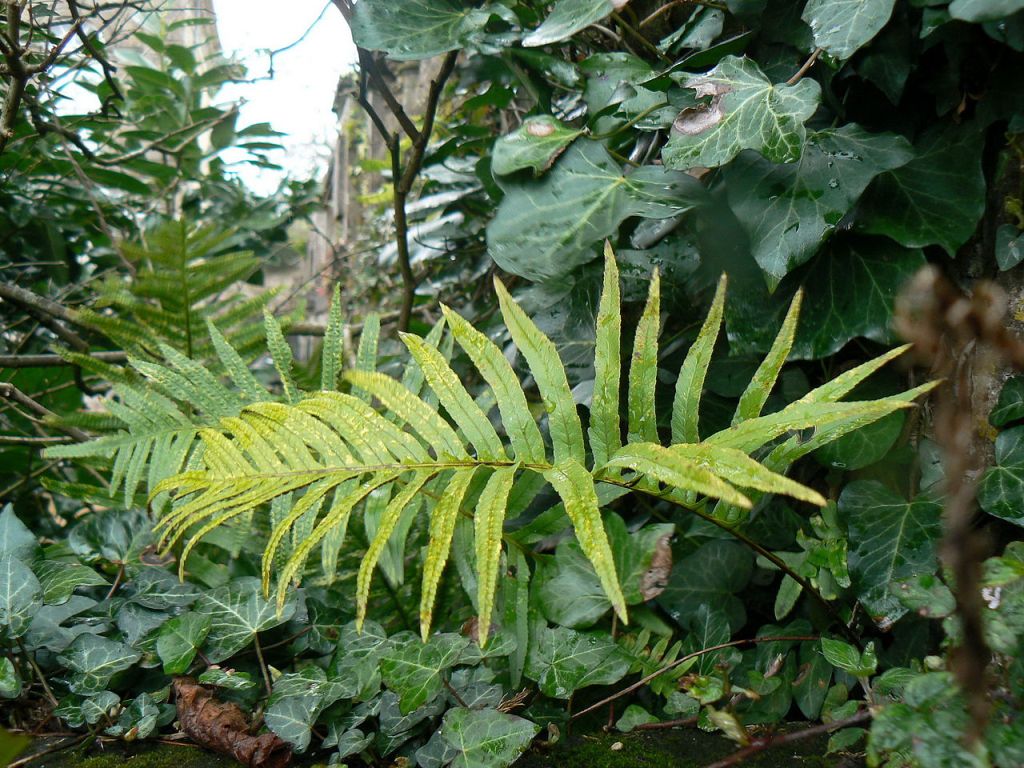
P. cambricum or Southern Polypody
A perennial, rhizomatous fern of well-drained base-rich rocky substrates, often found on sheltered limestone cliffs, old quarry faces, castle walls built of limestone, and on old mortared walls.

